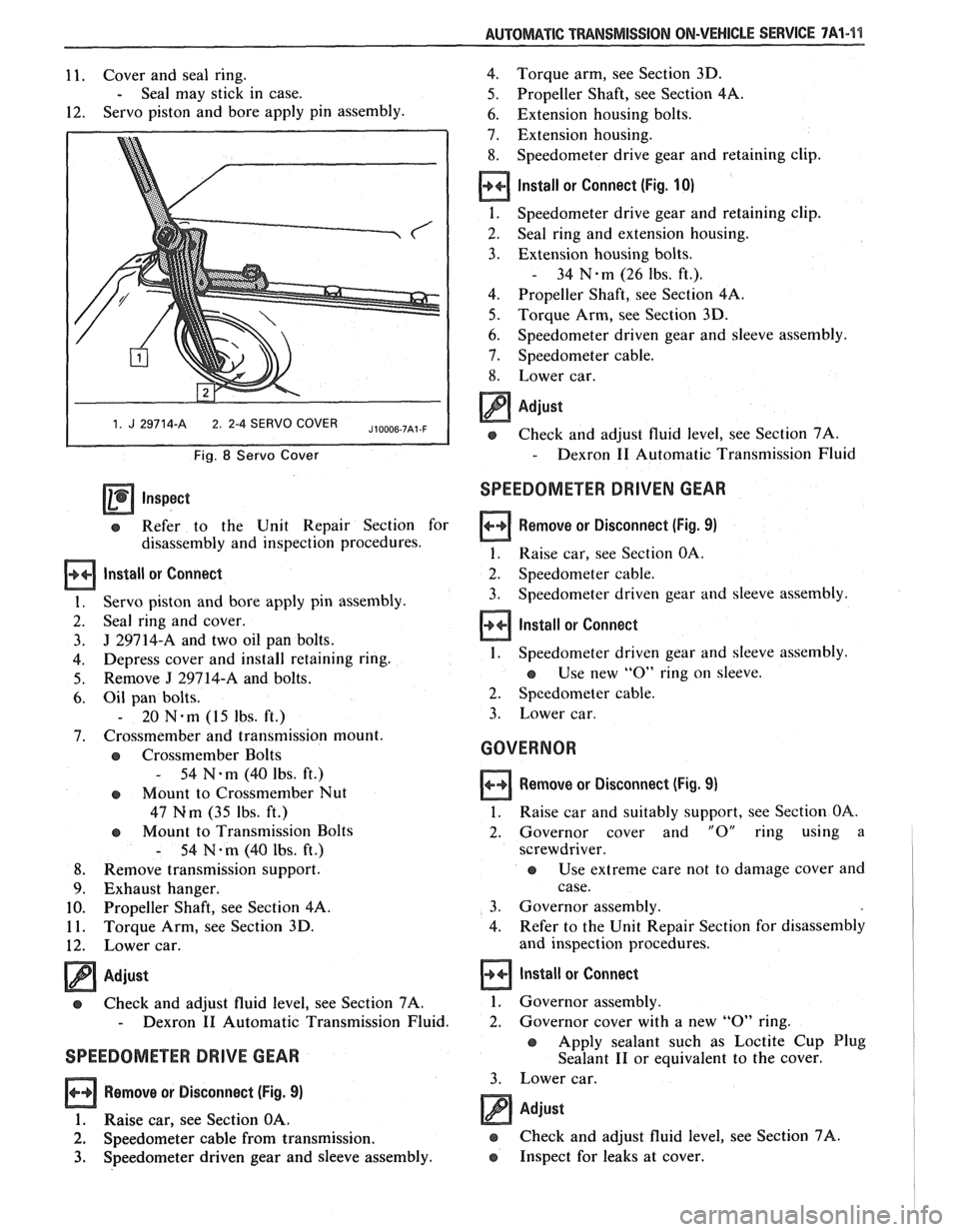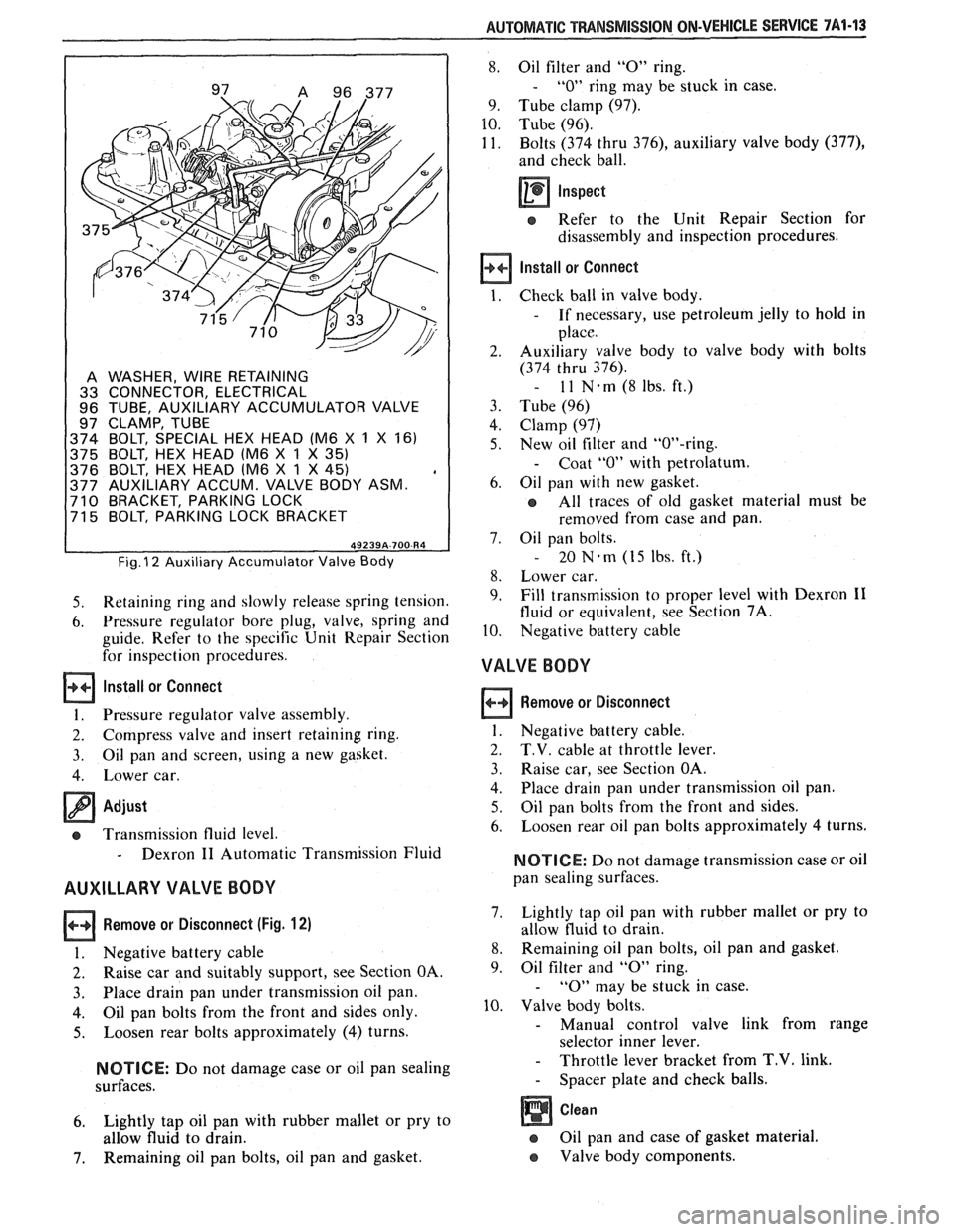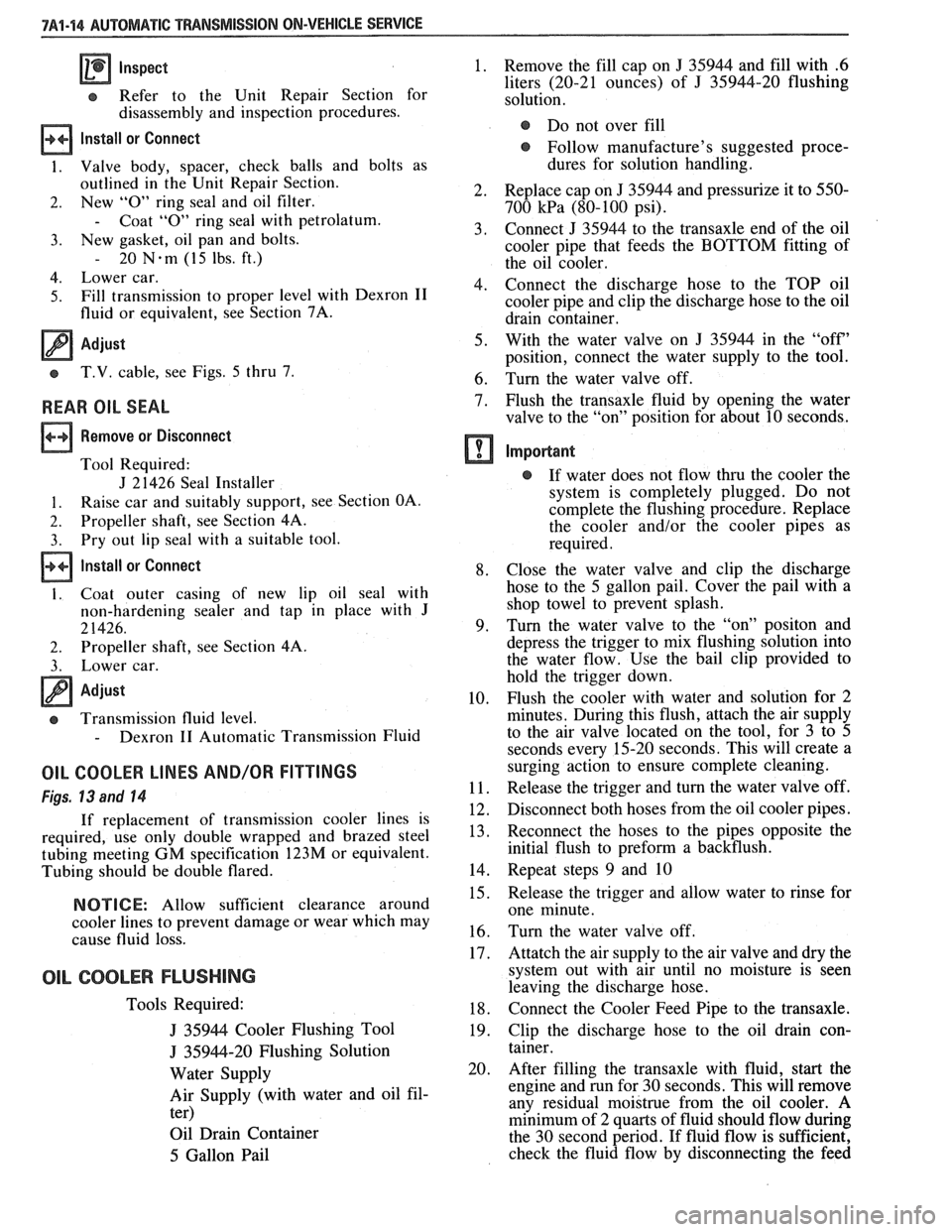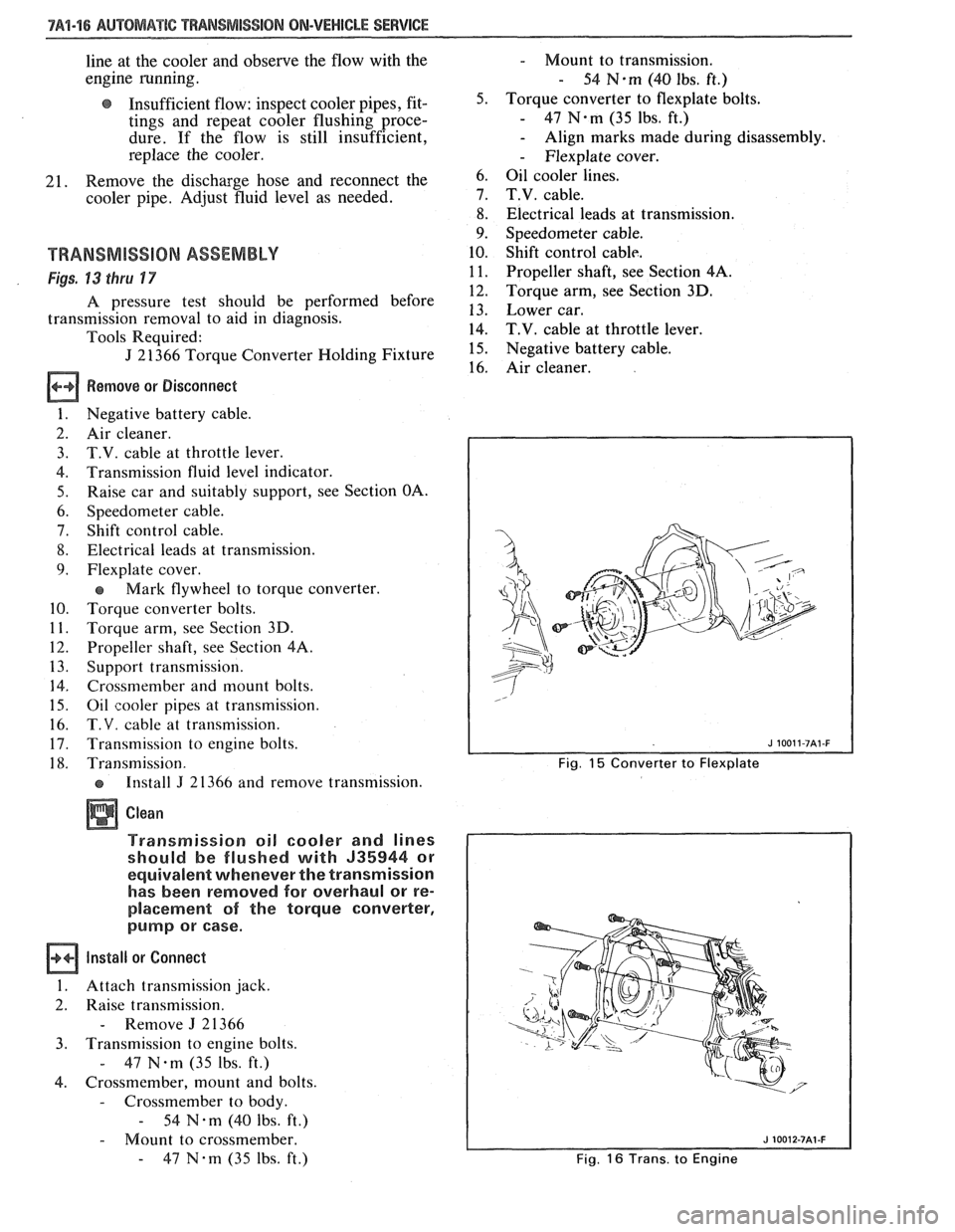1988 PONTIAC FIERO transmission fluid
[x] Cancel search: transmission fluidPage 1130 of 1825

AUTOMATIC TMNSMISSIOM ON-VEHICLE SERVICE 7A1-%I
11. Cover and seal ring.
- Seal may stick in case.
12. Servo
piston and bore apply pin assembly.
1 1. J 29714-A 2 2-4 SERVO COVER I
Fig. 8 Servo Cover
Inspect
e Refer to the Unit Repair Section for
disassembly and inspection procedures.
lnstall or Connect
Servo piston and bore apply pin assembly.
Seal ring and cover.
J 29714-A and two oil pan bolts.
Depress cover and install retaining ring.
Remove
J 29914-A and bolts.
Oil pan bolts.
- 20 N-m (15 lbs. ft.)
Crossmember and transmission mount.
Crossmember Bolts
- 54 N-m (40 Ibs. ft.)
e Mount to Crossmember Nut
47 Nm (35
Ibs. ft.)
e Mount to Transmission Bolts
- 54 N-m (40 lbs. ft.)
Remove transmission support.
Exhaust hanger.
Propeller Shaft, see Section 4A.
Torque Arm, see Section 3D.
Lower car.
Adjust
a Check and adjust fluid level, see Section 7A.
- Dexron I1 Automatic Transmission Fluid.
SPEEDOMETER DRIVE GEAR
Remove or Disconnect (Fig. 9)
1. Raise car, see Section OA.
2. Speedometer cable from transmission.
3. Speedometer driven gear and sleeve assembly. 4.
Torque arm, see Section 3D.
5. Propeller Shaft, see Section
4A.
6. Extension housing bolts.
7. Extension housing.
8. Speedometer drive gear and retaining clip.
Install or Connect (Fig. 10)
1.
Speedometer drive gear and retaining clip.
2. Seal
ring and extension housing.
3. Extension housing bolts.
- 34 N.m (26 Ibs. ft.).
4. Propeller Shaft, see Section 4A.
5. Torque Arm, see Section 3D.
6. Speedometer driven gear and sleeve assembly.
7. Speedometer cable.
8. Lower car.
a Adjust
e Check and adjust fluid level, see Section 7A.
- Dexron I1 Automatic Transmission Fluid
SPEEDOMETER DRIVEN GEAR
Remove or Disconnect (Fig. 9)
1. Raise car, see Section OA.
2. Speedometer cable.
3. Speedometer
driven gear and sleeve assembly.
Install or Connect
1. Speedometer driven gear and sleeve assembly.
a Use new "0" ring on sleeve.
2. Speedometer cable.
3. Lower car.
GOVERNOR
Remove or Disconnect (Fig. 9)
1. Raise car and suitably support, see Section OA.
2. Governor cover and "0" ring using
a
screwdriver.
e Use extreme care not to damage cover and
case.
3. Governor assembly.
4. Refer to the Unit Repair Section for disassembly
and inspection procedures.
Install or Connect
1. Governor assembly.
2. Governor
cover with a new
"0" ring.
e Apply sealant such as Loctite Cup Plug
Sealant
I1 or equivalent to the cover.
3. Lower car.
Adjust
e Check and adjust fluid level, see Section 7A.
e Inspect for leaks at cover.
Page 1131 of 1825

7A1-12 AUTOMATIC TRANSMISSION ON-VEHICLE SERVICE
SOME MODELS I--- - .-
10 CASE, TRANSMISSION 35 SEAL, CASE EXTENSION TO CASE
36 EXTENSION, CASE 37 BOLT, CASE EXTENSION TO CASE 39 SEAL ASSEMBLY, CASE EXTENSION OIL 40 RETAINER, SPEEDO DRIVEN GEAR FITTING
41 BOLT €31 WASHER ASSEMBLY 42 SEAL, "0" RING (SPEEDO FITTING TO
CASE EXTENSION)
43 FITTING ASSEMBLY, SPEEDO DRIVEN GEAR
44 GEAR, SPEEDO DRIVEN 45 GOVERNOR ASSEMBLY
46 COVER, GOVERNOR
98 NUT, FLANGED HEX
99 SPEED SENSOR, INTERNAL TRANSMISSION
100 STUD, DOUBLE END 687 SHAFT, OUTPUT 688 CLIP, SPEEDO DRIVE GEAR
689 GEAR, SPEEDO DRIVE
690 SLEEVE, OUTPUT SHAFT NOT USED ON 691 SEAL, OUTPUT SHAFT ALL MODELS
FILLER TUBE
Remove or Disconnect (Fig. 1 1)
1. Fluid, level indicator.
2. Raise car and suitably support, see Section OA.
3. Bolt retaining filler tube to transmission.
4. Loosen tube from transmission.
5. Lower car.
6. Pull tube out of car from the top.
Install or Connect
1. Filler tube.
2. Raise car.
3. Locate filler tube on transmission.
- Use new filler tube seal.
4. Filler tube bolt to transmission.
@ 47 N.m (35 lbs, ft.) - V8
@ 75 N-m (55 lbs. ft.) - V6
5. Lower car.
6. Fluid level indicator.
e Check and adjust fluid level, see Section 7A.
e Inspect for leaks.
Fig. 9 Speedometer Drive/Driven Gears
688 CLIP, SPEEDO DRIVE GEAR
689 GEAR, SPEEDO DRIVE
699 ROTOR, INTERNAL TRANSMISSION SPEED
SENSOR
J10007-7A1 -F
Fig. 10 Drive Gear
1. V6- 75 N.rn (55 LBS. FT.) V8-47 N.rn (35 LBS. FT.)
2. FILLER TUBE
3. FLUID LEVEL INDICATOR
4. SEAL
Fig. 11 Filler Tube and Indicator
PRESSURE REGULATOR VALVE
Remove or Disconnect
1. Raise car and suitably support, see Section OA.
2. Drain transmission oil pan.
3. Oil pan and screen.
4. Compress
pressure regulator valve with small
screwdriver.
Page 1132 of 1825

AUTOMATIC TRANSMISSION ON-VEHICLE SERVICE 7A1-13
A WASHER, WIRE RETAINING
33 CONNECTOR, ELECTRICAL
96 TUBE, AUXILIARY ACCUMULATOR VALVE
97 CLAMP, TUBE
374 BOLT, SPECIAL HEX HEAD (M6
X 1 X 161
375 BOLT, HEX HEAD lM6
X 1 X 35)
376 BOLT, HEX HEAD lM6 X 1 X 45) , 377 AUXILIARY ACCUM. VALVE BODY ASM. 710 BRACKET, PARKING LOCK
71 5 BOLT, PARKING LOCK BRACKET
Fig. I2 Auxiliary Accumulator Valve Body
5. Retaining ring and slowly release spring tension.
6. Pressure regulator bore plug, valve, spring and
guide. Refer to the specific Unit Repair Section
for inspection procedures.
Install or Connect
1. Pressure regulator valve assembly.
2. Compress valve and insert retaining ring.
3. Oil pan
and screen, using a new gasket.
4. Lower car.
Adjust
cs Transmission fluid level.
- Dexron I1 Automatic Transmission Fluid
AUXILLARY VALVE BODY
Remove or Disconnect (Fig. 12)
I. Negative battery cable
2. Raise car and suitably support, see Section OA.
3. Place drain
pan under transmission oil pan.
4. Oil pan bolts from the front and sides only.
5. Loosen rear bolts approximately (4) turns.
NOTICE: Do not damage case or oil pan sealing
surfaces.
6. Lightly tap oil pan with rubber mallet or pry to
allow fluid to drain.
7. Remaining oil pan bolts, oil pan and gasket.
8. Oil filter and "0" ring.
- "0" ring may be stuck in case.
9. Tube clamp (97).
10. Tube (96).
11. Bolts (374 thru
376), auxiliary valve body (377),
and check ball.
Inspect
e Refer to the Unit Repair Section for
disassembly and inspection procedures.
Install or Connect
Check ball in valve body.
- If necessary, use petroleum jelly to hold in
place.
Auxiliary valve body to valve body with bolts
(374 thru 376).
- 11 N-rn(8lbs.ft.)
Tube (96)
Clamp (97)
New oil filter and "OW-ring.
- Coat "0" with petrolatum.
Oil pan with new gasket.
All traces of old gasket material must be
removed from case and pan.
Oil pan bolts.
- 20 Nem (15 Ibs. ft.)
Lower car.
Fill transmission to proper level with Dexron
I1
fluid or equivalent, see Section 7A.
Negative battery cable
VALVE BODY
Remove or Disconnect
1. Negative battery cable.
2. T.V. cable at throttle lever.
3. Raise car, see Section OA.
4. Place
drain pan under transmission oil pan.
5. Oil pan bolts from the front and sides.
6. Loosen
rear oil pan bolts approximately 4 turns.
NOTICE: Do not damage transmission case or oil
pan sealing surfaces.
7. Lightly
tap oil pan with rubber mallet or pry to
allow fluid to drain.
8. Remaining oil pan bolts, oil pan and gasket.
9. Oil
filter and
"0" ring.
- "0" may be stuck in case.
10. Valve body bolts.
- Manual control valve link from range
selector inner lever.
- Throttle lever bracket from T.V. link.
- Spacer plate and check balls.
Oil pan and case of gasket material.
e Valve body components.
Page 1133 of 1825

7A1-44 AUTOMATIC TRANSMISSION ON-VEHICLE SERVICE
Inspect
e Refer to the Unit Repair Section for
disassembly and inspection procedures.
Install or Connect
1. Valve body, spacer, check balls and bolts as
outlined in the Unit Repair Section.
2. New
"0" ring
seal and oil filter.
- Coat "0" ring seal with petrolatum.
3. New gasket, oil pan and bolts.
- 20 N.m (15 lbs. ft.)
4. Lower car.
5. Fill
transmission to proper level with Dexron
I1
fluid or equivalent, see Section 7A.
Adjust
e T.V. cable, see Figs. 5 thru 7.
REAR OIL SEAL
Remove or Disconnect
Tool Required:
J 21426 Seal Installer
1. Raise car and suitably support, see Section OA.
2. Propeller shaft, see Section 4A.
3. Pry out lip seal with a suitable tool.
Install or Connect
I. Coat outer casing of new lip oil seal with
non-hardening sealer and tap in place with
J
2 1426.
2. Propeller
shaft, see Section 4A.
3. Lower car.
Adjust
e Transmission fluid level.
- Dexron 11 Automatic Transmission Fluid
OIL COOLER LINES AND/OR FITTINGS
Figs. 13 and 14
If replacement of transmission cooler lines is
required, use only double wrapped and brazed steel
tubing meeting
GM specification 123M or equivalent.
Tubing should be double flared.
NOTICE: Allow sufficient clearance around
cooler lines to prevent damage or wear which may
cause fluid loss.
OIL COOLER FLUSHING
Tools Required:
J 35944 Cooler Flushing Tool
J 35944-20 Flushing Solution
Water Supply
Air Supply (with water and oil fil-
ter)
Oil Drain Container
5 Gallon Pail
1. Remove the fill cap on J 35944 and fill with .6
liters (20-21 ounces) of J 35944-20 flushing
solution.
@ Do not over fill
@ Follow manufacture's suggested proce-
dures for solution handling.
Replace cap on
J 35944 and pressurize it to 550-
700
kPa (80-100 psi).
Connect
J 35944 to the transaxle end of the oil
cooler pipe that feeds the BOTTOM fitting of
the oil cooler.
Connect the discharge hose to the TOP oil
cooler pipe and clip the discharge hose to the oil
drain container.
With the water valve on
J 35944 in the "off'
position, connect the water supply to the tool.
Turn the water valve off.
Flush the transaxle fluid by opening the water
valve to the "on" position for about 10 seconds.
Important
@ If water does not flow thru the cooler the
system is completely plugged. Do not
complete the flushing procedure. Replace
the cooler
and/or the cooler pipes as
required.
8. Close the water valve and clip the discharge
hose to the 5 gallon pail. Cover the pail with a
shop towel to prevent splash.
9. Turn the water valve to
the
"on" positon and
depress the trigger to mix flushing solution into
the water flow. Use the bail clip provided to
hold the trigger down.
10. Flush the
cooler with water and solution for 2
minutes. During this flush, attach the air supply
to the air valve located on the tool, for 3 to 5
seconds every 15-20 seconds. This will create a
surging action to ensure complete cleaning.
11. Release the trigger and turn the water valve off.
12. Disconnect both hoses from the oil cooler pipes.
13. Reconnect the hoses to the pipes opposite the
initial flush to preform a backflush.
14. Repeat steps 9 and 10
15. Release the trigger and allow water to rinse
for
one minute.
16. Turn the water valve off.
17. Attatch the air supply to the air valve and dry the
system out with air until no moisture is seen
leaving the discharge hose.
18. Connect the Cooler Feed Pipe to the transaxle.
19. Clip the discharge hose to the oil drain con-
tainer.
20. After filling the transaxle with
fluid,
start the
engine and run for 30 seconds. This will remove
any residual
moistrue from the oil cooler. A
minimum of 2 quarts of fluid should flow during
the 30 second period. If fluid flow is sufficient,
check the fluid flow by disconnecting the feed
Page 1135 of 1825

7Al-16 AUWBMATIC TWANSMIS810N ON-VEHICLE SERVICE
line at the cooler and observe the flow with the
engine running.
@ Insufficient flow: inspect cooler pipes, fit- 5.
tings and repeat cooler flushing proce-
dure. If the flow is still insufficient,
replace the cooler.
21. Remove the discharge hose and reconnect the
cooler pipe. Adjust fluid level as needed. 7.
8.
9.
TRANSMISSION ASSEMBLY 10.
Figs. 73 tkru 1 7
A pressure test should be performed before
transmission removal to aid in diagnosis.
Tools Required:
J 21366 Torque Converter Holding Fixture
Remove or Disconnect
1. Negative battery cable.
2. Air cleaner.
3. T.V.
cable at throttle lever.
4. Transmission fluid level indicator.
5. Raise
car and suitably support, see Section
OA.
6. Speedometer cable.
7. Shift control cable.
8. Electrical leads at transmission.
9. Flexplate cover.
e Mark flywheel to torque converter.
10. Torque converter bolts.
11. Torque arm, see Section 3D.
12. Propeller shaft, see Section
48.
13. Support transmission.
14. Crossmember and mount bolts.
15. Oil cooler pipes at transmission.
16. T.V. cable at transmission.
17. Transmission to engine bolts.
18. Transmission.
a Install J 21366 and remove transmission.
Clean
Transmission oil cooler and lines
should be Flushed with
J35944 or
equivalent whenever the transmission
has
been removed for overhaul or re-
placement of the torque converter,
pump or case.
Install or Connect
1. Attach transmission jack.
2. Raise transmission.
- Remove J 21 366
3. Transmission to engine bolts.
- 44N.m(35 Ibs. ft.)
4. Crossmember, mount and bolts.
- Crossmember to body.
- 54 N .m (40 lbs. ft.)
- Mount to crossmember.
- 44 W-m (35 lbs. ft.)
- Mount to transmission.
- 54 N-m (40 Ibs. ft.)
Torque converter to flexplate bolts.
- 47 N-m (35 lbs, ft.)
- Align marks made during disassembly,
- Flexplate cover.
Oil cooler lines.
T.V. cable.
Electrical leads at transmission.
Speedometer cable.
Shift control cable.
11. Propeller shaft, see Section 4A.
12. Torque arm, see Section 3D.
13. Lower car.
14.
T.V. cable at throttle lever.
15. Negative battery cable.
16. Air cleaner.
Fig. 15 Converter to Flexplate
Fig.
16 Trans. to Engine
Page 1136 of 1825

AUTOMATIC TFIANSMISSION ON-VEHICLE SERVICE 7A1-17
Fluid Capacity
@ Pi111 Kcmoval .................. 10 pinls (4.7 1,ilres)
@ Ovcrliaul ..................... 13 pints ( l0.0 I,irrcs)
Recommended Fluid
Dcxroli I1 Auronii~tic 11.ansniission I-'luitl # 105 1x55
@ Shift control cable.
T.V. cable
@ Fluid level
- Dexron I1 Automatic Transmission Fluid
Fig. 17 Transmission Converter Shield
Page 1143 of 1825

Install or Conned
1. New seal using Tool J 21426.
2. Propeller shaft. (See Section 4A)
3. Lower vehicle.
4. Check transmission fluid level.
SPEEDOMETER DRIVEN GEAR
Remove or Disconnect
1. Raise vehicle.
2. Speedometer cable.
3. Lock plate and retaining bolt.
4. Pry gear fitting and shaft from housing.
5. O-ring from fitting.
Install or Connecl
1. Coat driven gear shaft and new O-ring with
transmission lubricant.
2. New O-ring.
3. Insert shaft.
4. Position fitting into extension housing.
5. Lock plate and retaining bolt.
6. Speedometer cable.
7. Lower vehicle.
TRANSMISSION
Figure 4
Disassemble
@ Exterior of the transmission assembly
thoroughly with appropriate solvent.
1. Remove drain bolt on transmission case and
drain lubricant.
2. Position offset lever in neutral gate (centered).
NO"6CE: Removal of offset lever in position
other than neutral (centered) may result in driving
the roll pin into the detent plate without releasing
lever, making further disassembly extremely
difficult.
3. Using pin punch and hammer, remove roll pin
attaching offset lever to shift rail (Figure
6).
Figure 6 Offset Lever (Removal and Installation)
4. Extension housing-to-transmission case bolts.
5. Housing and offset lever as an assembly (Figure
7) *
NOTICE: Do not attempt to remove the offset
lever while the extension housing is still bolted in
place. The lever has a positioning lug engaged in
the housing detent plate which prevents moving
the lever far enough for removal.
6. Detent ball and spring from offset lever (Figure
8)
7. Roll pin from extension housing or offset lever.
8. Carefully pry oiling funnel from rear of counter-
shaft (Figure
9).
9. Bolts attaching transmission cover and shift fork
assembly to case.
NOTICE: Two of the transmission cover attach-
ing bolts are alignment-type dowel bolts. Note
the location of these bolts for assembly reference.
10. Cover (Figure 10). I
Page 1159 of 1825

7C-2 CLUTCH
PRELIMINARY CHECKS
Before attempting to repair the clutch,
transmission or related hydraulic components for any
reason other than
an obvious failure, the problem and
probable cause should be identified.
A large percentage
of clutch and manual transmission
problenls are
manifested by shifting difficulties such as high shift
effort, gear clash and grinding or transmission
blockout. When any of these problems occur, a careful
analysis of these difficulties should be accomplished
and the following checks and adjustments performed
in the presented sequence before removing the clutch
or transmission for repairs.
Before
removal of the clutch hydraulic system,
verify the malfunction by renloving the clutch housing
dust shield and
measure the travel of the clutch slave
cylinder push rod. With clutch pedal pushed fully to
the floor, the
slave cylinder push rod should extend
14.53mm (0.57 inch) minimum against the clutch
release lever. Do
not replace the hydraulic system if
push rod travel exceeds this distance.
If slave cylinder does not meet the travel require-
ments, check the reservoir fluid level. The slave cylinder
must be in place when checking the fluid level. The proper
level is indicated by a step on the reservoir. Fill to the
specified level with
GM Delco Supreme No. 11 Brake
Fluid or an equivalent fluid that meets DOT
3 specifica-
tions. Do not overfill. The upper portion of the reservoir
must accept fluid that is displaced from the slave cylinder
as the clutch wears.
NOTICE: Carefully clean the top and sides of the
reservoir before opening to prevent contamination of
the system with dirt, water or other foreign material.
Remove the reservoir diaphragm before adding fluid.
Carefully replace the diaphragm, cover gasket and
cover after filling.
If the reservoir requires any fluid, check the
hydraulic system components for leakage. Remove the
rubber boots from the cylinder and check for leakage
past the pistons. A slight wetting of the surfaces is
acceptable. Replace the system, if excessive leakage is
evident.
BLEEDING CLUTCH SYSTEM
allowed to fall so low that air has been drawn into the
master cylinder.
NOTICE: Never, under any circumstances, use
fluid which has been bled from a system to fill the
reservoir as it may be aerated, have too much
moisture content and possibly be contaminated.
Clean dirt and grease from the cap to ensure no
foreign substances enter the system.
Remove cap and diaphragm and
fill reservoir to
the top with approved brake fluid only. (Brake
fluid must be certified to DOT 3 specifications).
Fully loosen bleed screw which is in the slave
cylinder body next to the inlet connection.
Fluid will now begin to move from the master
cylinder down the tube to the slave. It is
important that for efficient gravity
fill, the
reservoir must be kept full at all times.
It will be noticeable at this point that bubbles will
appear at the bleed screw outlet. This means that
air is being expelled. When the slave is full, a
steady stream of fluid will come from the slave
outlet. At this point tighten bleed screw to a
torque of 2
N .m.
Assemble diaphragm and cap to the reservoir,
fluid in reservoir should be level with step.
Exert a light load (approximately 20 lbs.) to the
slave cylinder piston by pushing release lever
towards the cylinder and loosen bleed screw.
Maintain a constant light load, fluid and any air
that is left will be expelled through the bleed port.
Tighten bleed screw when a steady flow of fluid
and no air is being expelled.
Renew fluid level in reservoir, assemble
diaphragm and cap. If necessary, repeat Steps
7
and 8.
Exert light load to release lever as in Step 7 (do
not open bleed screw), piston in slave will move
slowly down bore. Repeat 2-3 times, fluid
n~oven~ent will force any air left in the system into
the reservoir.
The hydraulic system should now be fully bled
and should release the clutch. Check vehicle by
starting, pushing clutch pedal to the floor and
selecting reverse gear. There should be no grating
of gears, if there is, the hydraulic system could
still contain air. If this is the case, repeat bleed
The process of removing air from the
line and procedure.
cylinders is known as "bleeding" and is necessary Check push rod travel at the
slave cylinder to insure
whenever the level of fluid in the reservoir has been the minimum travel
of
14.53mm (0.57 inch) for V-8
and 1 lrnm (0.43 inch) for V-6.